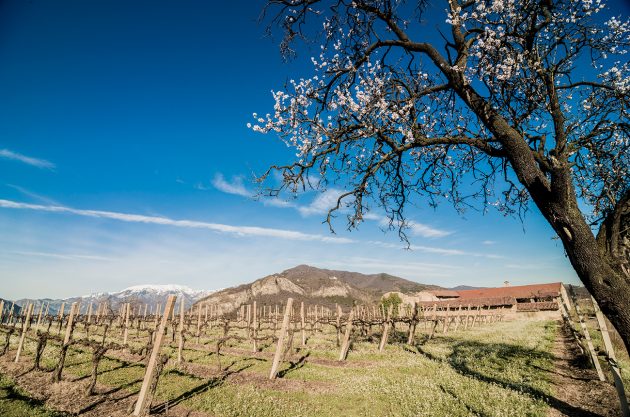Many of the factors that make Franciacorta special are already known. The climate, being in a region that claims to be ‘pre-Alpine’, is fiercely continental but has two mitigating factors: Lake Iseo to the north and Monte Orfano to the south. The proximity of the lake has a huge mitigating effect on temperatures in both summer and winter.
Evidence of this lies in Franciacorta’s typically Mediterranean vegetation, which includes both wild and naturalised plant species along with those that are easy to cultivate, such as the olive tree.
In the growing period for the vines (April to October) the average rainfall is 500-600 mm, approximately two thirds of the annual total.
The Franciacorta area is triangular in shape, with an apex in the north that touches the southern shores of Lake Iseo.
Within this triangular space, we can quite clearly make out the morainic amphitheatre formed during the Ice Age, thanks to a large glacier coming from Val Camonica, which divided into two branches immediately after the basin of the lake, with a small one to the east and a much larger and more important one to the west.
On the northwest side lies Paratico and Capriolo with their higher altitudes.
The first glacial branch from this side includes Clusane, Colombaro, Nigoline, Torbiato, Erbusco, Adro, Bornato, Monterotondo, Provaglio and also Passirano.
The Eastside includes Monticelli, Ome, and Rodengo, while Gussago and Cellatica, with their southern exposition, are part of a different glacial configuration.

No less important is Monte Orfano, which shelters Franciacorta from the humidity of the Padana valley.
Monte Orfano has limestone soils, quite different from the morainic origin of the rest of Franciacorta. Here the style of wine is tighter and chalkier.
The morainic origin of the other parts of the region is equally crucial. Morainic soils mean that pH values are not as high as in Champagne and acidity is almost half of the level obtainable in the Champagne region.
This means that sparkling wines in Franciacorta are made with a focus on extracting the purest expression possible from the grapes, without an oxidative style.
Soils in the region are rich in sand and silt and typically lacking in clay, often with considerable thickness and high permeability.
Abundant stones of different shapes, types and colours are scattered everywhere, and for centuries they have been used for constructing villas, farmhouses and ‘Broli’, the characteristic stone walls that surround houses and vineyards.
One of the basic characteristics of Franciacorta’s moraine-originating soils is an enormous wealth of added minerals, which are different to those derived only from the rocks found there, and form the basis for the area’s high-quality viticulture.
Franciacorta wines to try:

Wines tasted and rated by Decanter contributor Aldo Fiordelli
Arici, Millesime Pas Dosé, 2015 12.5%
Colline della Stella winery is in the extreme east of Franciacorta. Here in Gussago, on old terraced vineyards planted on chalky soil, the talented Andrea Arici produces some of the tightest and most mineral pas dosé sparkling wines in Franciacorta. Bright straw colour in the glass with pinprick bubbles, focused salted lemon and sugared almond, with wax and hints of petrol on the nose. Zesty in acidity and lightly tannic on a rich toasted finish. A wine built to last, with long persistent bubbles. 91
Barone Pizzini, Animante Extrabrut, NV 12%
Barone Pizzini’s vineyards are located in the northwest heartland of Franciacorta. The grapes are harvested in Provaglio D’Iseo, Passirano, Cortefranca and Capriolo. The latter stands out for its northern position and its altitude. Animate was the first Franciacorta to be blended with Erbamat, the late-maturing grape rediscovered in the region. The final blend is Chardonnay 77%, Pinot Nero 17%, Pinot Bianco 3%, and Erbamat 3%. Elegant citrus and alcohol nose, hints of apricot and acacia honey give way to fresh green apple and a mineral finish. The attack is crisp, with a firm persistent mousse, fresh on the palate and well-balanced at the end with a tight-knit texture. Will evolve with age in the bottle. 90
Montenisa Antinori, Brut Cuvée Royale, NV 12.5%
Picked in Erbusco, Villa Maggi and Borgo Calino, this Chardonnay-based wine comes from the heart of Franciacorta and is part of the Antinori stable. Milky notes dominate the nose, completed by hazelnut, lemon peel and yoghurt. Zesty acidity is finely grained with lemon flavour expressing an incredibly long mousse with a toasty finish and lemon curd flavour. 90
Faccoli, Rosé Brut, NV 12.5%
This estate is based on Monte Orfano, the southernmost hill of Franciacorta, and compared to other villages within the region, it’s higher in altitude with limestone soil . Faccoli is famously the first to start the harvest every year. This rosé is made with the saignée method. Bright onion-skin colour, classic profile with restrained strawberry fruit and candied strawberries, smoky woodland and mouth-filling chalky minerality. Creamy mousse and silky finish with good body. 92
More on Franciacorta:
Franciacorta – modernity with history
Franciacorta: Lombardy’s fashionable fizz
What is Satèn wine? – Ask Decanter









